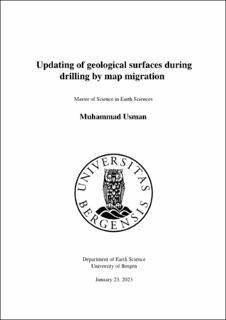| dc.contributor.author | Usman, Muhammad | |
| dc.date.accessioned | 2023-02-08T07:13:02Z | |
| dc.date.issued | 2023-01-23 | |
| dc.date.submitted | 2023-02-07T23:00:03Z | |
| dc.identifier.uri | https://hdl.handle.net/11250/3049071 | |
| dc.description.abstract | The accuracy of the geological surfaces in an earth model is dependent on the estimation of the velocities from surface seismic data. The dataset recorded from reverse VSP of the drill bit continuous signal can be utilized to update the velocity model during the drilling. Map migration of geological surfaces through developed algorithms using the new velocity information can improve the geological model ahead of the drill bit and can save well cost. To this end, this thesis proposes a mapping model for time-to-depth conversion that updates the geological surfaces by using the drill bit seismic waves. Travel time is calculated using ray tracing which is converted to depth using the revised velocities. The thesis methodology is divided into two main parts: the first part calculates the travel time and sampling for the property cube while the second part develops a computational model that converts the interpreted geological surfaces to accurate depth as well as calculates the uncertainty on the updated horizon. This research preprocesses the 2.5D geological model in NORSAR 3D for calculating zero offset two travel time through forward modeling. The velocity model is resampled through linear interpolation after mapping it from the depth domain to the time domain. The interval velocity is integrated over time to calculate the depth for each of the common midpoints (CMP). The proposed model repeats the process with the updated velocity model recorded from the reverse VSP. The revised depth values are compared with the reference depth values calculated from NORSAR 3D. The inputs for the computational model are the geological interpretation (TWT), initial velocity model, and updated velocity model from drill bit seismic waves. This research also explores the effect of uncertainty translated from input datasets to the depth values of the geological surfaces through bootstrapping. The final results indicate that algorithms developed update the geological surfaces through map migration by utilizing the updated velocity model. The uncertainty translation gives a range of depth variation. The results clearly demonstrate that the mapping model can reduce the rig downtime and eventually save the well cost. | |
| dc.language.iso | eng | |
| dc.publisher | The University of Bergen | |
| dc.rights | Copyright the Author. All rights reserved | |
| dc.title | Updating of geological surfaces during drilling by map migration | |
| dc.type | Master thesis | |
| dc.date.updated | 2023-02-07T23:00:03Z | |
| dc.rights.holder | Copyright the Author. All rights reserved | |
| dc.description.degree | Master's Thesis in Earth Science | |
| dc.description.localcode | GEOV399 | |
| dc.description.localcode | MAMN-GEOV | |
| dc.subject.nus | 756199 | |
| fs.subjectcode | GEOV399 | |
| fs.unitcode | 12-50-0 | |
| dc.date.embargoenddate | 2024-01-23 | |
